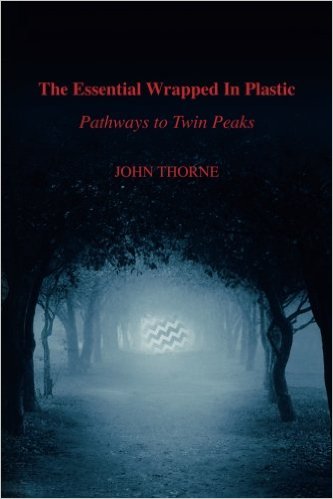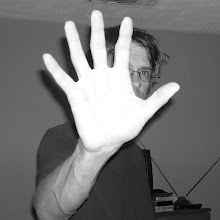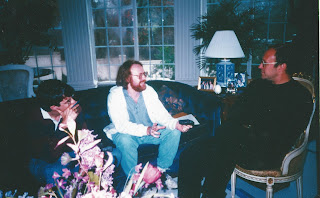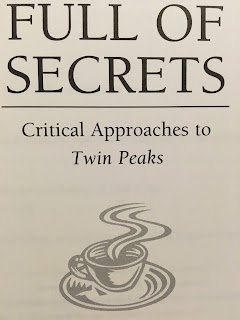Professor David Lavery, well known to
Twin Peaks fans as editor of the book,
Full of Secrets: Critical Approaches to Twin Peaks, passed away on August 30, 2016. Lavery was one of the first people to bring an
academic focus to
Twin Peaks: He edited a special
Twin Peaks issue of
Literature/ Film Quarterly and then
produced
Full of Secrets, a landmark
study of
Twin Peaks that has remained
in print for 22 years. Lavery went on to produce more than a dozen books of academic analysis for other well-known TV series, including
Buffy The Vampire Slayer, The X-Files, The Sopranos, Deadwood, Lost, and
Madmen. Although Lavery would achieve great acclaim for these later works, I always felt that his first book,
Full of Secrets, was his most important. It laid the groundwork for the decades of
Twin Peaks academic study to follow.
When we started Wrapped
In Plastic, Craig Miller and I knew that Twin Peaks was ripe for in-depth analysis and we strove to produce
such analyses in the pages of our magazine.
We were excited when we heard about Full
of Secrets and saw that other authors and scholars were taking Twin Peaks seriously.
We had a chance to meet and interview David Lavery when he
visited Dallas on May 21, 1994. The following interview first appeared (in
slightly longer form) in WIP 13
(October, 1994). Our talk about Twin Peaks occurred at a time when we
were only beginning to investigate and fully appreciate the complexities of the series, and, as a result, some of our notions about the
show had yet to fully form . . . .
Miller: When Twin Peaks first came on television what
was your initial reaction?
Lavery: I didn't
watch it. I missed the whole first eight
episodes. During those episodes I kept hearing everyone talking about it at the
office; even the secretaries were watching it.
They were always talking about it, and a couple of colleagues of mine
were always talking about it. So, by the
time the reruns started I knew I had to start watching it.
I was instantly hooked.
I started taping it right away. I
taped all that summer as they reran the eight episodes and had my first Twin Peaks party for the premiere of the
second season. I was just blown away by
the opening of that show. The old
bellhop and all of that--and of course that was exactly the point that the
secretaries stopped watching it. I came
to the office the next day and they said, "What was that?! What was that so slow for?" I think that happened to a lot of
people. The opening of the second season
was almost a challenge to the Twin Peaks
viewership.
Thorne: Do you
think that might have been deliberate?
DL: I don't know how deliberate it was. But all the talk was that people were
disappointed because Laura's killer had not been revealed--all the
disappointment in the press and outright anger about the fact that we didn't
know the killer. The first fifteen
minutes are absolutely endless, up until the Giant appearing. Of course, I was just fascinated with
it. I like TV the most is when it is so
absolutely perplexing. It certainly put
up a challenge to some viewers. And
don't forget, too, there were people coming in for the first time that night
hoping to finally pick up on this cultural phenomenon. And what did it do? It gave them that opening. I wonder how many television sets were
turned off in that first fifteen minutes?
CM: I was
disappointed with the second season premiere. I agree with David Bianculli who said that
every time Twin Peaks needed a
blockbuster episode, it fell down. It
was the episode after that really excelled.
DL: One of the reasons the network didn't like
it, finally, is that they didn't know how to market it. Genre, as Horace Newcomb has found out over
the years, is essentially a marketing tool.
If they don't know what to say Twin
Peaks is, then how are they going to push it? Certainly in one sense it was a soap opera,
and yet if it's soap opera, it's a given that the viewer can enter it anywhere
and that it exhibits a narrative redundancy.
It allows you back into a series even if you haven't watched it in ten
years. Twin Peaks defied that. It
did some of that, but it didn't do it enough--not for somebody coming in new.
CM: It seemed to
be playing into the critics worst criticisms.
Its bad rap was that the producers weren't really concerned about
resolving the storyline. Viewers wanted
some hint that they were conscious of these concerns and at least interested in
moving the story ahead.
DL: Cooper does get clues from the Giant, but
they were just baffling utterances that you knew were going to take episodes
and episodes to reveal. Again, it's a
matter of expectations isn't it? If
people have been watching it thinking, "this is a night-time soap"
then they wouldn't have been so anxious for closure. That's the definition of soaps--they don't
have closure.
JT: That's the
argument in Marc Dolan's essay in your book.
DL: Right.
Twin Peaks did a very bad job
of setting up its expectations.
Saturday Night Live had just been on
with the parody of the show's endlessness with the suggestion that Cooper was
perpetuating this indefinitely! And the
network ran
that ad
that shows the smoke-filled room with the TV executives sitting around a table
saying, "Saturday night?! You put
our best shows on Saturday night?! Heads
are going to roll!" The network, in
self-reflexivity of modern television--the “deride and conquer” strategy that
Mark Crispin Miller calls it--was making fun of itself as a peremptory
strike. How could they lose? "We know we made a stupid mistake, and
if it turns out to be the stupid mistake we know it is then we'll claim that we
didn't do it, because we've already made fun of it!" And when they finally changed it back to
Thursday night they did that
Wizard of Oz
spoof, "We've been in an awful place on Saturday night. That
is
a bad dream."
JT: Although you
didn't watch Twin Peaks' initial
first season run, were you aware of the pre-pilot hype? The media blitz that was going on?
DL: Yeah.
I can remember sitting in a conference in Birmingham, Alabama and
reading a big story in USA Today. I remember some big magazine articles
including one in Connoisseur:
"The show that will change television forever."
JT: Do you think
the show lived up to that hype? Do you
think it has changed television?
DL: Of course not. It hasn't changed TV a bit. They put on an
innovative show. It was canceled. Where's the change? Isn't that what Mark Frost said,
essentially?
You can watch TV today and see an occasional Twin Peaks influence. You notice how it has changed the visual
style. But TV is so monolithic; it seems
incredibly difficult to change it. I
think you could argue that The Simpsons
has changed TV. But I obviously think Twin Peaks is an incredibly significant
show. I have this battle with colleagues
all the time. They look at me like I'm
deranged: "You've done a book on Twin
Peaks?!"
JT: Many
correlations have been made between Twin
Peaks and various literary works, as was done in Literature/Film Quarterly.
Since you are chairman of an English department, did you notice these
allusions as you watched the show?
DL: Yeah, I
noticed the allusions as we went along.
Of course that was part of the snob appeal of
Twin Peaks. Diane Hume
George, in her essay, writes quite well about that. She wrote one of the first really good
articles on
Twin Peaks in
Ms.
She says that you were just not going to associate with anybody who
didn't get
Twin Peaks! I can remember feeling that way. Fellini used to say about
Satyricon that you should take people to
it to see who was your friend. There was
that kind of quality to
Twin Peaks;
that's part of the classic cult experience.
I write about this in my essay.
You want to have this group that you identify with. They're your interpretive community. You all know how to read the text. I was actually quite gratified when the
secretaries stopped watching the show.
It was, "I knew you couldn't get it."
CM: How did you
go about soliciting essays for your book?
DL: When the show was canceled I had a letter out
within a week. I wrote everybody I could
think of. I got their addresses out of
the Professional Directory. I said,
"I'm going to develop a collection of essays on Twin Peaks, would you like to write something?" I got a good number of responses. I wrote the Modern Language Association,
which had 65 people who had proposed papers for a session on Twin Peaks, which unfortunately was
never held. I think I got about 40 essays submitted for the book. I was the
sole arbiter--I judged them. I figured
out which essays would go and which would stay.
A good number of essays that came in were literary in
nature. I wasn't pleased at how literary
they were. I knew this book was going to
need a television look so it could be used in television studies classes. I think the book does have a strong
television focus to it. I took the
really good literary essays and talked Jim Welsh of Literature/Film Quarterly into doing a special literary issue. I actually had another one planned, a
Feminist issue. I tried to talk Camera Obscura into doing that, but they
didn't want to do it.
JT: It seems to
me there would be a lot of interest in studying Lynch's work from a Feminist
approach.
DL: Well there are four Feminist essays in the
book. I worry that some of the essays
may overlap or that there might be a little too much emphasis on the Feminist
stuff.
I got other submissions that I just thought were
hare-brained. My favorite one was
"Twin Peaks and The Fairy Queen."
The Fairy Queen was an epic
poem of the early Renaissance by Edwin Spencer.
I thought, "This is what English people do!" But then by the end of the series we have
Windom Earle and Leo in their "verdant bower" which is a direct quote
from The Fairy Queen! The verdant bower is one of the famous scenes
from The Fairy Queen. I thought, "I owe these people an
apology!"
Twin Peaks had an
unbelievably rich text. It could
interest people, who were semiotically inclined, on so many different
levels. Even some of the bad episodes
are inexhaustibly rich.
Twin Peaks at its worst was still
mesmerizing.
CM: Getting back
to the book, did you consider how the various essays would "interact"
with each other, so that the book would work as a whole?
DL: Yeah, I always had an overall flow for the
book in mind. I knew there was going to
be a Feminist core, and I wanted to have a couple of essays that set the show
into the television industry. I thought
Dolan's essay did that very well. I knew
that the discussion section was going to go last.
CM: Why include
some essays that had already been printed elsewhere, such as the Martha Nochimson
essay from Film Quarterly, or the
Diane Hume-George essay from Ms.?
DL: Some of those were so well-known that it seemed
a definitive book on Twin Peaks
should include them. I think about 75%
of the book is new material. Jonathan
Rosenbaum's essay was published elsewhere.
And of course he does not like Lynch.
JT: Why did you
choose the Rosenbaum essay, a negative article, to lead off the book?
DL: Rosenbaum's first for sales. I worried about it, but Rosenbaum's such a
big name. He's done about ten books and
he's one of the really well-known film critics.
Of course, that's the only essay that's totally hostile.
I tried to get Rosenbaum to write an updated essay, because
his is basically a review from when Twin
Peaks first came on. I don't agree
with Rosenbaum, either. I put it first,
partly to get it out of the way. It's a
very short essay. You have to remember
that he is not a life-long "hater" of Lynch. He happens to think Eraserhead is one of the greatest films ever made. Rosenbaum has always been an avant-garde film advocate. The point he makes is that Lynch has never
had to explain why things happen in his movies.
Would Lynch have explained why the lights are flickering in the morgue
if that scene was in Eraserhead? Nothing is explained in Eraserhead! It's good enough
that it wasn't explained. His argument
is that there has been a gradual coarsening of Lynch.
JT: Fire Walk With Me doesn't get as much
attention in the book as the series.
DL: That's mainly due to logistics. The essays were written before the film came
out. I asked the authors to include
anything they could about it for their final revisions. I included a few things for my introduction,
but there's not much else.
JT: Opinion of
the film varies dramatically depending on who you talk to. What did you think of it?
DL: I thought it was interesting, but I was
greatly disappointed by it. It was only
after I read the Video Watchdog essay
that I thought I could convince myself that I really liked it. I did go see it again and I liked it
better. A lot of people hated it,
though. I did include a plot summary of
the film in the book, but I had a student do that. I just couldn't force myself to sit down and
do it.
CM: Were you
disappointed because they did a prequel, or did you think the film just wasn't
well made?
DL: Well, there was just so much missing. The humor, that wonderful leaven that was
there in the series, was gone. Suddenly
it was this incredibly depressing, heavy-handed film. There's still a great debate about the
ending, which I know you guys liked and Video
Watchdog liked. But I disliked the
ending about as much as I disliked the ending of Wild At Heart, of which it was a virtual clone, with the angels
descending and all of that. That's when
I think Lynch is at his absolute worst.
Like anybody I wanted to see the story continue. I wanted to see Cooper get out of the
bathroom. And I guess he's never going
to.
JT: But in many
respects the fact that Cooper has been possessed by Bob is an ending. The evil has, perhaps, been victorious.
DL: Yeah, but we still don't know what happened
in Pittsburgh. If you read the Cooper
Autobiography it’s pretty clear that Cooper may have killed Earle's wife. That's something I suggest in my
introduction.
CM: You suggest
that maybe Bob had entered Cooper at an early age just as he had entered
Leland.
DL: We shouldn't work under the assumption that
Bob is only in one individual at a time.
I mean, Bob could be inhabiting various beings at various times. Just because he was in Leland doesn't mean he
couldn't have been in Cooper.
CM: But there's
no evidence that he can do that.
DL: But Bob knew all about Pittsburgh.
JT: Somebody once
suggested [to us] that maybe Bob's ultimate goal was to possess Cooper. He orchestrated this entire thing--including
Windom Earle and Laura--to get Cooper to that certain place and point in time
where he could possess him.
DL: As an English teacher, though, if you came to
me in a literature class and suggested that theory, I would say, "What in
the text leads you to say that?" I
think it's a fascinating hypothesis, but there is
nothing in
Twin Peaks
other than a bunch of strange conjunctions that would lead you to believe that
it was true. I don't doubt for a minute
that it might be where the story was going, but if you don't find some evidence
for it in the text, it doesn't make any sense.
JT: Well,
excluding the Cooper Autobiography--let's just say only the series is the
text--are there any clues that lead you to believe that Cooper was possessed by
Bob at one point?
DL: That Bob knows about Pittsburgh. How does Bob know about that?
JT: I might interpret that to say Bob had been
possessing Windom Earle.
DL: Well, we don't know his relationship with
Earle. I mean he dispatches Earle so
quickly. Earle has been this menacing figure
for all these episodes and then he's done away with so quickly in the Black
Lodge. That was one of the disappointing
things about the last episode.
Do we know that Lynch and Frost knew? Did they have it sketched out?
JT: Frost has
said that they he had a vague idea of where they would go in the third
season.
DL: We're talking wing and a prayer here anyway,
aren't we? As Dolan shows, they were
making this up as they went along--to a great degree--because they never knew
how long the show was going to continue.
They had to leave it open-ended enough so that they could continue it.
CM: In that Behind the Scenes special that Alan
Thicke hosted, both Lynch and Frost were asked about how well thought-out the
plotlines were. Lynch answered,
"Not too thought-out." But
Frost answered, "Very thought-out." [laughter]
DL: And which is it? Or could it be both?





















































